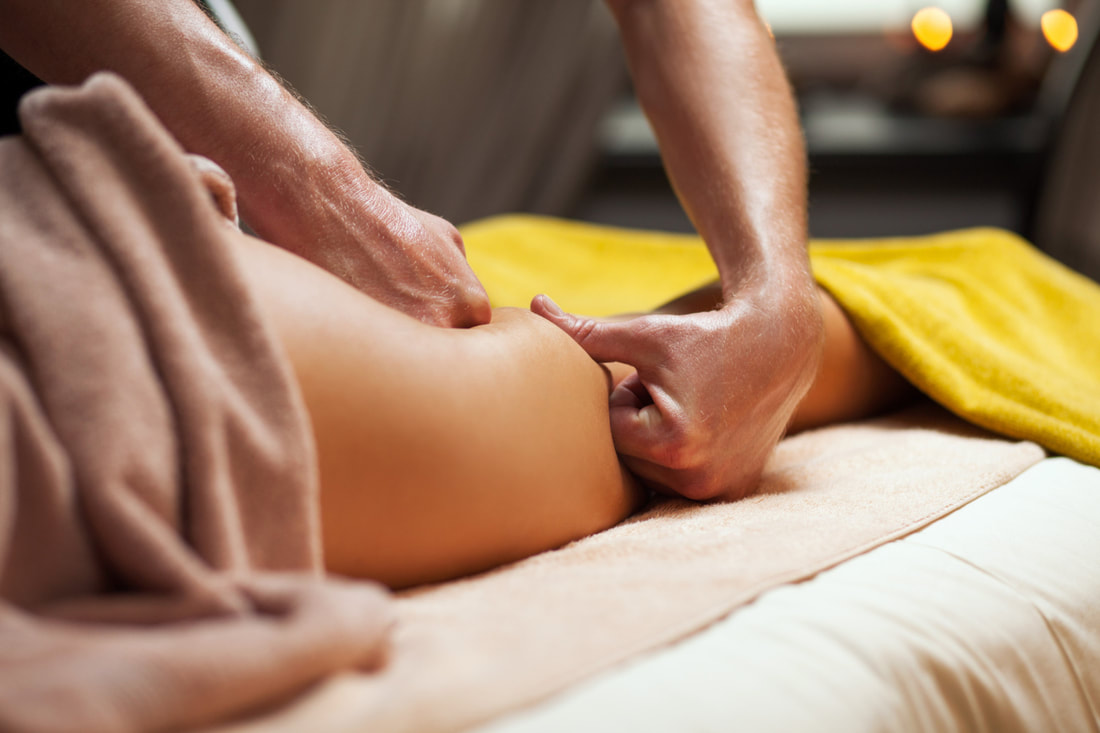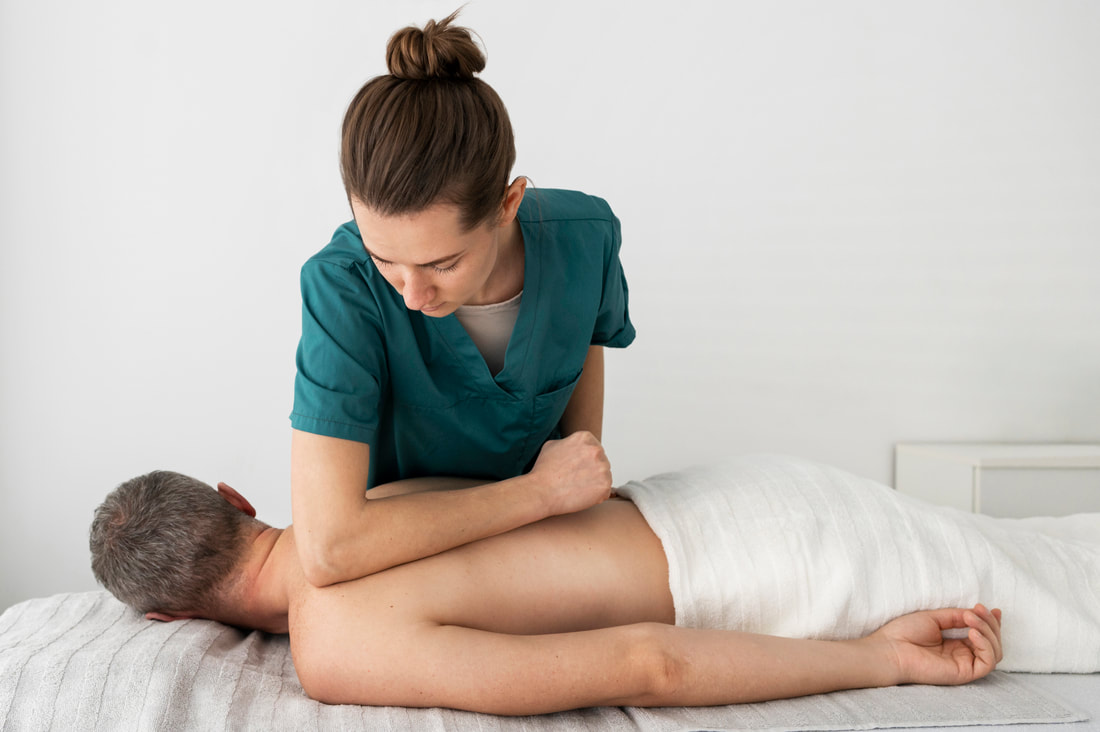
Deep Tissue Massage
Deep tissue massage is a therapeutic massage technique designed to target and alleviate tension in the deeper layers of muscles and connective tissues. This modality involves applying sustained, firm pressure and slow strokes to reach areas beyond the surface muscles. The primary objective is to release chronic muscle tension, break down adhesions (knots or bands of painful tissue), and improve overall mobility.
During a deep tissue massage, a massage therapist may use their fingers, thumbs, elbows, or forearms to apply intense pressure on specific areas. This focused approach aims to address issues such as muscle stiffness, chronic pain, and limited range of motion. It is essential for individuals seeking deep tissue massage to communicate their comfort levels and any pain thresholds with the therapist to ensure a beneficial and personalized experience. Deep tissue massage is often recommended for those with chronic muscle problems, injuries, or those who prefer a more intense massage experience.
Deep tissue massage is a therapeutic massage technique designed to target and alleviate tension in the deeper layers of muscles and connective tissues. This modality involves applying sustained, firm pressure and slow strokes to reach areas beyond the surface muscles. The primary objective is to release chronic muscle tension, break down adhesions (knots or bands of painful tissue), and improve overall mobility.
During a deep tissue massage, a massage therapist may use their fingers, thumbs, elbows, or forearms to apply intense pressure on specific areas. This focused approach aims to address issues such as muscle stiffness, chronic pain, and limited range of motion. It is essential for individuals seeking deep tissue massage to communicate their comfort levels and any pain thresholds with the therapist to ensure a beneficial and personalized experience. Deep tissue massage is often recommended for those with chronic muscle problems, injuries, or those who prefer a more intense massage experience.
Benefits of Deep Tissue Massage
- Chronic Pain Relief: Alleviates persistent pain in muscles and joints.
- Muscle Tension Reduction: Releases tightness and knots in muscles.
- Improved Posture: Aids in correcting postural imbalances.
- Enhanced Mobility: Increases flexibility and range of motion.
- Injury Rehabilitation: Supports recovery from sports injuries or accidents.
- Scar Tissue Reduction: Helps break down and reduce scar tissue.
- Faster Injury Healing: Promotes faster healing of muscle and tissue injuries.
- Joint Health: Benefits the health and flexibility of joints.
- Balanced Muscle Function: Restores balance to muscle groups.
- Lowered Blood Pressure: Can contribute to reduced blood pressure levels.
- Stress Reduction: Relieves stress by targeting deep-seated tension.
- Improved Circulation: Enhances blood flow and oxygen delivery.
- Toxin Elimination: Assists in flushing out metabolic waste from tissues.
- Headache Relief: Alleviates tension headaches and migraines.
- Enhanced Athletic Performance: Supports athletes in muscle recovery.
- Sciatica Relief: Eases pain associated with sciatic nerve issues.
- Reduced Arthritis Symptoms: Provides relief from arthritis-related discomfort.
- Better Sleep Quality: Promotes relaxation and improved sleep patterns.
- Balanced Emotions: May contribute to emotional well-being and relaxation.
- Decreased Anxiety: Helps reduce anxiety and promote a sense of calm.
- Improved Breathing: Relaxes respiratory muscles, aiding in better breathing.
- Fibromyalgia Symptom Relief: Offers relief for fibromyalgia-related pain.
- Increased Serotonin Production: May contribute to improved mood.
- Scar Tissue Healing: Supports more effective healing of surgical scars.
- Enhanced Posture Awareness: Encourages awareness of body posture.
- Reduced Cellulite: Stimulates lymphatic drainage, potentially reducing cellulite.
- Improved Digestion: Promotes relaxation in abdominal muscles.
- Enhanced Athletic Recovery: Aids in quicker recovery for athletes.
- Boosted Immune System: Can contribute to improved immune function.
- Release of Endorphins: Promotes a natural mood boost and pain relief.
- Improved Nervous System Function: Supports a healthier nervous system.
- Reduced TMJ Discomfort: Alleviates tension associated with TMJ disorder.
- Better Quality of Life: Overall improvement in physical and mental well-being.
Does Deep Tissue Massage Hurt?
Deep tissue massage can be uncomfortable at times, and individuals may experience sensations ranging from mild discomfort to a temporary feeling of pain. Unlike a gentle Swedish massage, which primarily focuses on relaxation, deep tissue massage involves applying firm pressure and targeted techniques to reach deeper layers of muscles and connective tissues. The goal is to address chronic tension and knots.
Deep tissue massage can be uncomfortable at times, and individuals may experience sensations ranging from mild discomfort to a temporary feeling of pain. Unlike a gentle Swedish massage, which primarily focuses on relaxation, deep tissue massage involves applying firm pressure and targeted techniques to reach deeper layers of muscles and connective tissues. The goal is to address chronic tension and knots.
How Fast Will I Get Results With A Deep Tissue Massage?
The speed at which you experience results from a deep tissue massage can vary depending on several factors, including the specific issues you're addressing, your overall health, and how your body responds to the massage. Here are some considerations:
It's important to be realistic about what one deep tissue massage can achieve. Many people ask for more pressure, thinking that if the therapist just pushes hard enough, they can get rid of all their knots in an hour. This just won't happen. So don't ask for: harder, harder, harder.
If the client insists on pressure levels that we deem unsafe or uncomfortable, it's within our professional right to refuse the request, we follow industry standards to ensure our safety. The client may need to visit other healthcare professionals.
The speed at which you experience results from a deep tissue massage can vary depending on several factors, including the specific issues you're addressing, your overall health, and how your body responds to the massage. Here are some considerations:
- Acute vs. Chronic Issues: For acute issues, such as muscle soreness from a recent workout, you may experience immediate relief. Chronic issues, like long-standing muscle tension or pain, may require multiple sessions to see significant and lasting results.
- Consistency: Regular sessions often yield more lasting results. If you have a specific concern, a series of sessions scheduled close together initially, followed by maintenance sessions, may be recommended.
- Severity of the Issue: The severity of your muscle tension or pain can influence how quickly you feel relief. More severe issues may take longer to address.
- Post-Massage Care: Following your self-care after a massage, such as hydration, stretching, and rest, can enhance and prolong the benefits.
- Individual Response: People's bodies respond differently to massage. Some individuals may experience immediate relief, while others may need time for their bodies to adjust.
It's important to be realistic about what one deep tissue massage can achieve. Many people ask for more pressure, thinking that if the therapist just pushes hard enough, they can get rid of all their knots in an hour. This just won't happen. So don't ask for: harder, harder, harder.
If the client insists on pressure levels that we deem unsafe or uncomfortable, it's within our professional right to refuse the request, we follow industry standards to ensure our safety. The client may need to visit other healthcare professionals.
Differences between a licensed massage therapist and a physical therapist?
Licensed Massage Therapists (LMTs) and Physical Therapists (PTs) are both healthcare professionals, but they have different scopes of practice, education, and roles in patient care. Here are the key differences between a Licensed Massage Therapist and a Physical Therapist:
Licensed Massage Therapists (LMTs) and Physical Therapists (PTs) are both healthcare professionals, but they have different scopes of practice, education, and roles in patient care. Here are the key differences between a Licensed Massage Therapist and a Physical Therapist:
- Scope of Practice:
- LMT (Licensed Massage Therapist): LMTs specialize in using manual manipulation of soft tissues, such as muscles, tendons, and ligaments, to address issues like muscle tension, pain, and relaxation. They may work in various settings, including spas, wellness centers, and private practices.
- PT (Physical Therapist): PTs focus on evaluating, diagnosing, and treating a wide range of musculoskeletal and movement-related conditions. They employ a broader range of interventions, including exercise, manual therapy, and patient education. PTs often work in hospitals, rehabilitation centers, outpatient clinics, and other healthcare settings.
- Education and Training:
- LMT: Education requirements for LMTs vary by jurisdiction, but they typically complete a massage therapy program that includes anatomy, physiology, and hands-on massage training. Training programs can range from several hundred to over a thousand hours.
- PT: Physical Therapists must earn a graduate degree, usually a Doctor of Physical Therapy (DPT) degree, from an accredited program. DPT programs involve extensive coursework in anatomy, physiology, biomechanics, and clinical experience. PTs also need to pass a licensing exam.
- Clinical Assessment and Diagnosis:
- LMT: LMTs perform assessments to understand clients' concerns, but they do not diagnose medical conditions. Their focus is on addressing muscular issues and promoting relaxation.
- PT: PTs conduct comprehensive assessments, including the diagnosis of musculoskeletal and movement disorders. They design treatment plans based on their assessments and collaborate with other healthcare professionals.
- Treatment Techniques:
- LMT: LMTs primarily use hands-on massage techniques, such as Swedish massage, deep tissue massage, and myofascial release, to address soft tissue issues.
- PT: PTs utilize a variety of interventions, including therapeutic exercises, manual therapy, joint mobilization, stretching, and modalities like ultrasound or electrical stimulation. Their goal is to improve mobility, strength, and overall function.
- Goal of Treatment:
- LMT: The primary goals are relaxation, relief from muscle tension, and general well-being. While massage therapy can have therapeutic benefits, the focus is often on addressing immediate concerns.
- PT: The primary goals are rehabilitation, functional improvement, and long-term management of musculoskeletal and movement disorders. PTs work towards restoring optimal function and preventing future issues.
- Regulation and Licensing:
- LMT: LMTs are regulated at the state level, and licensing requirements vary by state. They need to meet specific education and training standards and pass a licensing exam.
- PT: PTs are licensed at the state level and must hold a DPT degree. They also need to pass the National Physical Therapy Examination (NPTE) to practice.


